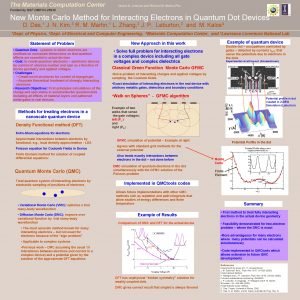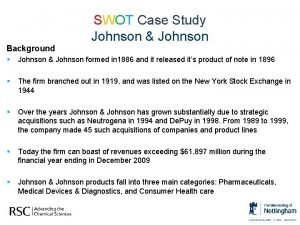The Materials Computation Center Duane D Johnson and

- Slides: 1

The Materials Computation Center Duane D. Johnson and Richard M. Martin (PIs) Funded by NSF DMR 03 -25939 New Monte Carlo Method for Interacting Electrons in Quantum Dot Devices D. 1 Dept. 1 Das, J. N. of Physics, 3 Kim, 2 Dept. R. M. 1 Martin, L. 2 Zhang, J. P. of Electrical and Computer Engineering, Methods for treating electrons in a nanoscale quantum device Density Functional method (DFT) 3 Materials and M. 4 Kalos Computation Center, and 4 Lawrence Livermore National Lab Example of quantum device New Approach in this work Statement of Problem • Quantum Dots: systems in which electrons are confined on nanoscale dimensions so that quantum effects are essential in actual devices • Goal: to create quantum alectronic – spintronic devices by control of electron number and spin as a function of device geometry and applied voltages • Challenges : • Create novel structures for control of charge/spin • Accurate theoretical treatment of strongly interacting electrons • Research Objectives: First-principles calculations of the charge and spin states in semiconductor quantum dots including all effects of material layers and patterned metal gates in real devices. 2 Leburton, Double dot – occupations controlled by gates – detected by currents IQPC that sense the potentials due to electrons in the dots • Solve full problem for interacting electrons in a complex device including all gate voltages and complex dielectrics Classical Green Function Monte Carlo GFMC Experimental circuit lay-out (Kouwenhoven) • Solve problem of interacting charges and applied voltages by sampling the Coulomb fields • Exact simulation of interacting electrons in the real device with arbitrary metallic gates, dielectrics and boundary conditions “Walk on Spheres” - GFMC algorithm PL Potential profile in dot created in 2 -DEG Simulation (Leburton) PR Example of two walks that sense the gate voltages: left (PL ) and right (PR ) Kohn-Sham equations for electrons Approximate interactions between electrons by functional, e. g. , local density approximation - LDA GFMC simulation of potential – Example at right Poisson equation for Coulomb Fields in Device Agrees with standard grid methods for the external potential Finite Element method for solution of coupled differential equations: Also treats exactly interactions between electrons in the dot – not done before Quantum Monte Carlo (QMC) Treat quantum system of interacting electrons by stochastic sampling of positions of electrons • Variational Monte Carlo (VMC): optimize a trial many-body wavefunction • Diffusion Monte Carlo (DMC): improve over variational function by trial many-body wavefunction DMC simulation of quantum electrons in the dot simultaneously with the GFMC solution of the Poisson problem Potential Profile in the dot Monte Carlo Finite Element Implemented in QMCtools codes Allows future implementations with other QMC methods sich as reptation and path integerals that allow studies of energy differences and finite temperature Example of Results Comparison of DMC and DFT for the actual device • The most accurate method known for many interacting electrons – but not exact for electrons because of the “sign problem” Summary • First method to treat fully interacting electrons in the actual device geometry • Feasibility demonstrated for two-electron problem – where the DMC is exact • Applicable to complex systems • More advantageous for many electrons where many potentials can be calculated simultaneously • Previous work – DMC assuming the usual 1/r interactions between electrons (not correct in a complex device) and a potential given by the solution of the approximate DFT equations • Code implemented in QMCtools which allows extension to future QMC developments References DFT has unphysical “broken symmetry” solution for weakly coupled dots DMC gives correct result that singlet is always favored Experiments by group of L. P. Kouwenhoven: J. M. Elzerman, et al. , Phys. Rev. B 67, 161308 (2003) Finite Element Method: P. Matagne and J. -P. Leburton, Phys. Rev. B 65, 235323 (2002). Previous collaborations comparing LDA/QMC: J. P. Leburton, S. Nagaraja , P. Matagne and R. M. Martin, Microelec J 34, 485 -489 (2003). Present Monte Carlo method: D. Das, Thesis, Universit of Illinois, 2005 D. Das, R. M. Martin, and M. Kalos, submtted to Phys. Rev. B.

